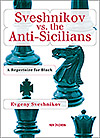 Sveshnikov vs. the
Anti-Sicilians
Sveshnikov vs. the
Anti-Sicilians
A Complete Repertoire for Black
by Evgeny Sveshnikov
2014
New in Chess
http://www.newinchess.com/
251 pages
Price € 25,95
ISBN 978-90-5691-545-2
The great Evgeny Sveshnikov inventor of the Sveshnikov variation, one
of the most uncompromising lines of the Sicilian Defence, provides the
reader here in a eye catching, high readable, club level repertoire
book on the Anti-Sicilians.
It does not matter what white plays at move 1…c5 the master of
attack comes with an excellent answer.
As we for example can see in the following model game: Spangenberg,Hugo
(2520) -
Krasenkow,Michal (2655) [B22]
Najdorf Festival op Buenos Aires (8), 31.10.1998
1.e4 c5 2.d4 cxd4 3.c3 e5 4.cxd4 exd4 5.Nf3 Nc6 6.Nxd4 Nf6 7.Nc3 Bb4
8.Nxc6 dxc6 9.Qxd8+ Kxd8 10.f3 Be6 11.Be3 Nd7 12.a3 Bd6 13.0-0-0 Kc7
14.f4 Nb6 15.Bd3 Nc4 16.Bxc4 Bxc4 17.e5 Be7 18.f5 Rad8 19.g4 Rd3
20.Rxd3 Bxd3 21.Bf4 Kc8 22.Re1 Rd8 23.e6 fxe6 24.Rxe6 Bh4 25.h3 Bc4
26.Re4 Bb3 27.Rb4 Bf7 28.Re4 g6 29.Be3 gxf5 30.gxf5 Bf6 31.h4 Bd5
32.Rg4 a6 33.Bg5 Rg8 34.Nxd5 cxd5 35.Rg3 h6 36.Bf4 Rxg3 37.Bxg3 h5
38.Kc2 Kd7 39.b3 Ke7 40.a4 Ba1 0-1.
Maybe white has to try a Fried Liver Like move as 6.Ng5!? please see
Mayhem in the Morra.
It is a pity for Nigel Davies in his GambiteerI book where he handles
the Wing Gambit 2.b4,but Sveshnikov sees nothing in it and waves it all
away with the moves: 1.e4 c5 2.b4 cxb4 3.a3 bxa3 4.Nxa3 d6 5.d4 Nf6
6.Bd3 g6 7.Ne2 Bg7 8.0-0 0-0 9.Rb1 Nc6 10.f4 Ng4,please see the game
Valguanerroa-Sveshnikov Torre Normano 2008.
This game is by the way good for nearly 2.5 pages of text.
Sveshnikov writes after 2.b4:The so called Wing Gambit.I think white
does better to play 2.Nf3 first to wait how black reacts.Thus after
2…d6 the gambit 3.b4!? is already perfectly correct,whereas on move
2,the advance of the b-pawn is premature.
Interesting even for white players are the analysed lines on 1.e4 c5
2.Ne2 and 1.e4 c5 2.Nc3 Nc6 3.Nge2 e5 4.Nd5 and now we are in the game
Kasparov – Sveshnikov,Podolsk 1994,where Kasparov and Sveshnikov where
neighbours from each other!
Conclusion: This is a brilliant
written repertoire book!
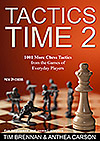 Tactics Time 2
Tactics Time 2
1001 More Chess Tactics from the Real
Games of Everyday Players
by Tim Brennan & Anthea Carson
2014
New in Chess
http://www.newinchess.com/
137 pages
Price € 14,95
ISBN 978-90-5691-537-7
There is no better way in chess to improve your tactical skills as
doing tactics!
This latest work from Tim Brennan & Anthea Carson holds over 1000
exciting exercises, all given from the point of view of the side to
move.
Tim Brenman is the creator of tactics Home and Anthea Carson is an
active USCF tournament chess player,author,blogger,chess teacher,chess
mom and author
of various thrillers, including The Dark Lake.
This book is really a great chess treasure but I found it a great pity
that there are in the solutions no references to the games.
Conclusion:Thrilling work!
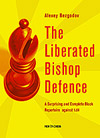 The Liberated Bishop
Defence
The Liberated Bishop
Defence
A Surprising and Complete Black
Repertoire against 1.d4
by Alexei Bezgodov
2014
New in Chess
http://www.newinchess.com/
334 pages
Price € 25,95
ISBN 978-90-5691-547-6
This latest move to move repertoire book from Grandmaster Alexei
Bezgodov is based on a early 1.d4 d5 2….Bf5.
A fine example of this all is the following model game from the
brilliant Alexander Morozevich: Landa,Konstantin (2641) -
Morozevich,Alexander (2758) [D06]
EU-Cup 28th Eilat (5.3), 15.10.2012
1.Nf3 d5 2.d4 Bf5 3.c4 e6 4.Nc3 Nf6 5.Bg5 c6 6.Qb3 Qb6 7.c5 Qc7 8.Nh4
Bg6 9.e3 Nbd7 10.Bf4 Qc8 11.Be2 Be7 12.0-0 Bd8 13.Qd1 0-0 14.Bd6 Re8
15.Nxg6 hxg6 16.f4 Ba5 17.Bd3 b6 18.Qa4 Bxc3 19.bxc3 b5 20.Qc2 Ng4
21.Qe2 Nh6 22.a4 a6 23.g4 f5 24.gxf5 exf5 25.Rf3 Nf6 26.Rg3 Kf7 27.Qg2
Qe6 28.Qa2 Rad8 29.axb5 axb5 30.Qa6 Qd7 31.Qa7 Ne4 32.Bxe4 fxe4 33.Kf2
Nf5 34.Rgg1 Rh8 35.Rg2 Rh3 36.Qb6 Rf3+ 37.Ke1 Rxe3+ 38.Re2 Rxe2+
39.Kxe2 Kg8 40.Ra7 Qe8 41.Qb7 g5 42.fxg5 Qh5+ 43.Ke1 Qxg5 44.Qf7+ Kh7
45.Be5 Qc1+ 46.Kf2 Qd2+ 47.Kg1 Qd1+ 48.Kg2 Rf8 49.Qxf8 Ne3+ 50.Kf2 Qd2+
51.Kg3 Qg2+ 0-1.
A brilliant game by Alexander Morozevich.The strong grandmaster
Konstantin Landa is very rarely so comprehensively and powerfully
outplayed.
Very interesting is chapter 11 with The Vanishing Bishop Opening 1.d4
d5 2.c4 Bf5 3.cxd5,this last means that our beloved light squared
bishop has to end his life on b1,because all other moves simple lose.
But first a fine example: Lagunow,Alexander (2420) - Hohelj,Stanislav
(2305) [D06]
Muenster op Muenster (8), 1993
1.d4 d5 2.c4 Bf5 3.cxd5 Bxb1 4.Qa4+ c6 5.Rxb1 Qxd5 6.Nf3 Nd7 7.a3 Ngf6
8.e3 Qf5 9.Ra1 e5 10.Be2 e4 11.Nd2 Nb6 12.Qc2 Qg6 13.g4 0-0-0 14.h4
Nxg4 15.h5 Qf5 16.Nxe4 Kb8 17.Rh4 Nh6 18.Bd2 Be7 19.Rh1 Ng4 20.Bd3 Qf3
21.Rg1 Bh4 22.Rxg4 Qxg4 23.Qd1 Qg1+ 24.Ke2 Qg4+ 25.Kf1 Qh3+ 26.Kg1 Rd5
27.Be2 f5 28.Nc3 f4 29.Nxd5 Bg3 30.fxg3 fxg3 31.Qe1 Qh2+ 32.Kf1 Qh1#
0-1.
As our author explains, this line is dangerous for black.Unlike in many
systems,it is important to know many precise variations.
It is the variation with 3.cxd5,in my opinion, which is responsible for
the relative lack of popularity of the entire defence 1.d4 d5 2.c4
Bf5,black players fear having to surrender their bishop,in case they
either fall under attack or end up with an unpleasant endgame.
One of the most dangerous lines is followed by the following model
game,but Alexei Bezgodov gives several improvements!
Khenkin,Igor (2675) - Goreacinic,Dmitri (2231) [D06]
Frankfurt-chA Frankfurt (5), 04.06.2012
1.d4 d5 2.c4 Bf5 3.cxd5 Bxb1 4.Qa4+ c6 5.Rxb1 Qxd5 6.Nf3 Nd7 7.b4 e6
8.Qc2 Ngf6 9.e3 a5 10.Bc4 Qh5 11.bxa5 Qxa5+ 12.Bd2 Qa4 13.Bb3 Qa6 14.e4
Be7 15.e5 Nd5 16.Bc4 Qa7 17.0-0 0-0 18.Qe4 Rfe8 19.h4 Nf8 20.h5 Rad8
21.Qg4 f5 22.exf6 Nxf6 23.Qh3 Nd5 24.Rfe1 Bf6 25.Re4 b5 26.Bb3 c5
27.dxc5 Qxc5 28.Rc1 Qd6 29.h6 g6 30.Rce1 Re7 31.Ng5 Rde8 32.Qd3 Rd7
33.Qf3 Bb2 34.Bb4 Nxb4 35.Rxe6 Nxe6 36.Rxe6 Rxe6 37.Bxe6+ Kh8 38.Qa8+
Rd8 39.Nf7+ Kg8 40.Nxd6+ 1-0.
As Bezgodov explains black could have equalised with immediate 18…b5!
Conclusion: One of those super reads
from New in Chess!
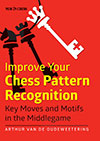 Improve Your Chess
Pattern Recognition
Improve Your Chess
Pattern Recognition
Key Moves and Motifs in the Middlegame
by Arthur Van de Oudeweetering
2014
New in Chess
http://www.newinchess.com/
301 pages
Price € 22,95
ISBN 978-90-569-547-1538-4
The Dutch International and chess trainer Arthur van de Oudeweetering
helps you at the hand of chess patterns and hundreds of surprising
middlegame themes to improve your middlegame skills.
A fine example of this all for example the Octopus as we can see in the
following model game: Jonkman,Harmen (2498) - Palacios Llera,Francisco
(2355) [B22]
WICC qual Moscow 25'+10 FIDE.com (4), 15.04.2002
1.e4 c5 2.c3 d5 3.exd5 Qxd5 4.d4 Nf6 5.Nf3 Bg4 6.dxc5 Qxd1+ 7.Kxd1 e5
8.b4 e4 9.h3 Bh5 10.g4 Nxg4 11.hxg4 Bxg4 12.Nbd2 Nc6 13.Bh3 Bxh3
14.Rxh3 exf3 15.Nxf3 Be7 16.Kc2 Bf6 17.a3 0-0 18.Be3 Rad8 19.Rah1 h6
20.Rg1 Kh7 21.Bg5 Bxg5 22.Nxg5+ Kg8 23.Ne4 Kh7 24.Nd6 Rd7 25.f4 f5
26.Rd3 g6 27.Re1 Rg7 28.Re6 a6 29.Nxb7 Nxb4+ 30.axb4 Rxb7 31.Rdd6 Rg7
32.Rxa6 h5 33.b5 Rc8 34.c6 h4 35.b6 h3 36.c7 h2 37.Ra1 Ra8 38.Rh1 Rf8
39.Rxh2+ Kg8 40.Rc6 Rh7 41.Rxh7 1-0, Oudeweetering explains after
15.Nxf3
Here too the outlines are clear:a strong square on d6,while the
supporting pawn on c5 is already there {the Botvinnik Slav features a
similar structure with colours reservered;it will not surprice you that
sometimes a knight pops up on d3 there}The simplified plan for white
is:exchange the dark squared bishops.
By the way several opening lines are likely to produce an octopus,for
instance: 1.e4 e6 2.d4 d5 3.Nc3 Bb4 4.e5 c5 5.Bd2 Ne7 6.Nb5 Bxd2+
7.Qxd2 0-0 8.f4 a6 9.Nd6 or 1.e4 e5 2.Nf3 Nc6 3.Bb5 a6 4.Ba4 Nf6 5.0-0
Be7 6.Re1 b5 7.Bb3 d6 8.c3 0-0 9.h3 Bb7 10.d4 Re8 11.Nbd2 Bf8 12.a4 h6
13.Bc2 exd4 14.cxd4 Nb4 15.Bb1 c5 16.d5 Nd7 17.Ra3 c4.
A other very important theme is cutting through the middle with e5-e6
as we can see in the following model game: Magem Badals,Jordi (2545) -
Movsziszian,Karen (2483) [B06]
Catalunya-chT Catalunya (8.1), 17.03.2012
1.e4 g6 2.d4 Bg7 3.Nc3 d6 4.Be3 a6 5.Nf3 b5 6.Bd3 Bb7 7.e5 Nd7 8.e6
fxe6 9.Ng5 Nf8 10.0-0 Nf6 11.Re1 Qd7 12.Bd2 h6 13.Nf3 g5 14.h3 Rg8
15.a4 b4 16.Ne4 Nxe4 17.Bxe4 Bxe4 18.Rxe4 Qc6 19.Qe2 a5 20.c3 bxc3
21.bxc3 Bf6 22.c4 h5 23.d5 exd5 24.cxd5 Qxd5 25.Bc3 Bxc3 26.Rxe7+ Kd8
27.Re8+ Kd7 28.Qe7+ Kc6 29.Rxa8 Bxa1 30.Qe8+ Kb6 31.Rb8+ Ka7 32.Rb5 Ng6
33.Qe1 Qc6 34.Qxa5+ 1-0.
Included are highly instructive exercises to see if you have learned
from Arthur’s lessons!
Conclusion: Arthur van de
Oudeweetering truly helps you to become a master in chess!
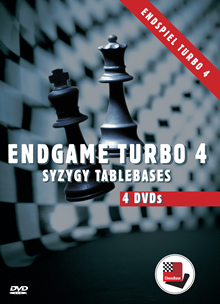
TrainingEndgame
ChessBaseDatabase
Endgame Turbo 4
2014
http://www.chessbase.com
E-Mail info@chessbase.com
Price Euro 59.90
Minimum: Pentium III 1 GHz, 1 GB RAM, Windows Vista, XP
(Service Pack 3), DVD-ROM drive, Deep Fritz 14, Komodo Chess 8, Houdini
4 or ChessBase 12/13, 20 GB free hard disk space. Recommended: PC Intel
Core i7, 2.8 GHz, 4 GB RAM, Windows 7 (64 Bit) or Windows 8/8.1, DVDROM
drive, Deep Fritz 14, Komodo Chess 8, Houdini 4 or ChessBase 12/13, 20
GB free hard disk space
These 4 endgame turbo DVD’s (Syzygy Tablebases} give
perfect endgame analysis in your Frits or ChessBase program, for
all newcomers tablebases are complete databases that provide perfect
answers for a set number of pieces,as on these DVD’s we find perfect
endgames for all five and 27 six-piece endgames (included the
rook,pawn,pawn,-rook endings} but they
need around 20 GB of yoyr hard disk place.
Latest chess engines as Komodo Chess 8 and Houdini 4 play these
endgames perfectly, because they use there endgame knowledge during the
analysis, and that makes it the perfect tool for correspondence, engine
matches and all who love to play around with endgames.
For example there is no need to buy Secrets of Rook Endings from John
Nunn, these DVD’do the work for you!
Personally I found these Tablebases fast running and my engines came
with fantastic results as chess mate in 54 moves!
Conclusion: A must for all {computer}
endgame lovers!
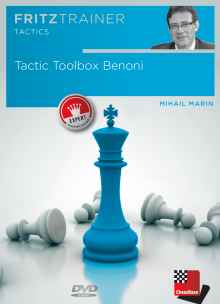
Training/Opening/Friztrainer/
Tactic Toolbox Benoni
by Mihail Marin
2014
http://www.chessbase.com
E-Mail info@chessbase.com
Price Euro 29.90
Pentium-Processor at 300 Mhz or higher, 64 MB RAM, Windows XP, Windows
Vista, Windows 7, DVD drive, mouse, soundcard
The Modern Benoni is one
of black’s most smashing openings and it belonged once to the main
weapon of the great Garry Kasparov.
John Nunn a other great expert on the Benoni described the Benoni as
follow: Black relies fairly heavily on tactical resources to vindicate
his opening play. Usually there will come a moment when black will have
to continue tactically to justify his plan, for otherwise his pieces
will be pushed back from there active squares and he will be reduced to
permanent passivity.
Mihail Marin has packed the Benoni course in instructive quizzes
where the aim lays in important key positions and tactical finesses.
Included are highly interesting databases on the ECO sections A69,A70
and A77.
The last database did hold the following beauty:
Donner,Jan Hein (2500) - Velimirovic,Dragoljub (2490) [A77]
Capablanca mem Havana (3), 1971
1.d4 Nf6 2.c4 c5 3.d5 g6 4.Nc3 Bg7 5.e4 0-0 6.Be2 d6 7.Nf3 e6 8.0-0
exd5 9.cxd5 Re8 10.Nd2 a6 11.a4 Nbd7 12.Re1 Rb8 13.Bf1 Ne5 14.f4 Neg4
15.Nf3 c4 16.a5 Qc7 17.e5 Qc5+ 18.Qd4 Qxd4+ 19.Nxd4 dxe5 20.fxe5 Nh5
21.Nf3 Nxe5 22.Nxe5 Bxe5 23.Be3 Bd7 24.Bxc4 Rbc8 25.Ba2 Rxc3 26.bxc3
Bxc3 27.Bf2 Rxe1+ 28.Rxe1 Bxe1 29.Bxe1 Nf6 30.Kf2 Bf5 31.Ke3 Be4 32.Kd4
Bxg2 33.Ke5 Kg7 34.Kd6 Kf8 35.Bb3 g5 36.Bg3 Ke8 37.Be5 Nd7 38.Ba4 Bh3
39.Bf6 h6 40.Kc7 Bf5 41.Kxb7 Kf8 42.Bxd7 Bxd7 43.Kxa6 1-0.
Included is an extra database of 147 entries where I found the
following game from Bobby Ficher:
Cuellar Gacharna,M - Fischer,R [A71]
Sousse (izt) 4/116 Sousse (izt) 4/116, 1967
1.d4 Nf6 2.c4 c5 3.d5 e6 4.Nc3 exd5 5.cxd5 d6 6.Nf3 g6 7.e4 Bg7 8.Bg5
h6 9.Bf4 g5 10.Bc1 0-0 11.Nd2 Nbd7 12.Be2 Ne5 13.Nf1 b5 14.Bxb5 Qa5
15.Ng3 c4 16.0-0 Rb8 17.Qa4 Qxa4 18.Bxa4 Nd3 19.Bb5 Ng4 20.Nge2 Nxc1
21.Raxc1 Ne5 22.b3 cxb3 23.axb3 a6 24.Ba4 Nd3 25.Rc2 f5 26.Ng3 f4
27.Nge2 f3 28.Ng3 fxg2 29.Kxg2 Bg4 30.Nf5 Nf4+ 31.Kg3 Bxf5 32.exf5 Bxc3
33.Kf3 Be5 34.Ke4 Rb4+ 35.Rc4 Rfb8 36.f6 Kf7 37.Kf5 Rxc4 38.bxc4 Ne2
39.Re1 Nd4+ 40.Kg4 h5+ 41.Kh3 Kxf6 0-1.
Video running time is: 4 hours and 45 minutes.
Conclusion: This trainings DVD holds a lot of value for it’s money!
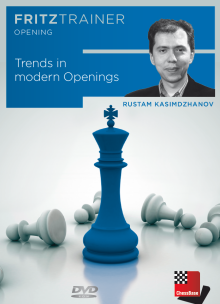
TrainingOpeningFriztrainer
Trends in modern openings
by Rustam Kasimdzhanov
2014
http://www.chessbase.com
E-Mail info@chessbase.com
Price Euro 29.90
Pentium-Processor at 300 Mhz or higher, 64 MB RAM, Windows XP, Windows
Vista, Windows 7, DVD drive, mouse, soundcard
The
great Rustam Kasimdzhanov show us as no other on this heavy loaded DVD
the secrets of modern openings play and he is not afraid to show us the
modern state of latest theory.
The author was second of Viswanathan Anand and many say it was the hand
of Kasimdzhanov who helped him defend the title so
successfully!
Interesting to mention are why some lines are so popular on top level
play and others not.
A fine example of modern play is The Berlin Wall:
1.e4 e5 2.Nf3 Nc6 3.Bb5 Nf6 4.0-0 [4.d3 Bc5] 4...Nxe4 5.d4 [5.Re1 Nd6
6.Nxe5 Be7 7.Bf1 Nxe5 (7...Nf5 8.Nf3 0-0 9.d4 d5 10.c3) 8.Rxe5 0-0
9.Nc3 (9.d4 Bf6 10.Re1) 9...Ne8 (9...Bf6 10.Re1 Nf5 11.Nd5) 10.Nd5 Bd6
11.Re2 c6 12.Ne3 Be7 (12...Bc7 13.Nf5 d5 14.Ne7+ Kh8 15.Nxc8 Rxc8 16.d3
f5 17.g3 Qf6 18.Bd2 Nd6 19.Bc3 d4 20.Bd2 Nf7 21.f4 1-0 (61) Vachier
Lagrave,M (2766)-Giri,A (2750) Biel 2014) 13.Qe1 Bf6 14.Nf5 d5 15.Ne7+
Kh8 16.Nxc8 Rxc8 17.g3 Qd7 18.d3 Nc7 ½-½ (45) Nakamura,H
(2787)-Aronian,L (2805) Saint Louis USA 2014] 5...Nd6 6.Bxc6 dxc6
[6...bxc6 7.dxe5 Nb7] 7.dxe5 Nf5 8.Qxd8+ Kxd8 9.h3!? Ke8 [9...Bd7
10.Rd1 Be7 11.g4 Nh4 12.Nxh4 Bxh4 13.Nd2 Kc8 14.Nf3 Be7 15.Rd3 c5
(15...h6 16.Nd4 Re8 17.Bf4 c5 18.Nf5 Bf8 19.c4 a6 20.Ne3 b5 21.b3 g5
22.Bg3 Be6 23.Rad1 ½-½ (42) Caruana,F (2782)-Grischuk,A
(2785) Warsaw 2013) 16.Bg5 c4 17.Rd4 Bc6 18.Bxe7 Bxf3 19.Kh2 Re8 1-0
(57) Caruana,F (2801)-Negi,P (2645) Tromsoe 2014] 10.Nc3 h5 [10...b6!?
11.Rd1 a) 11.Bf4 Bb4 12.Ne4 Ba6 13.Rfc1 Be2 14.Nfd2 (14.Nh2 Bc4 15.c3
Be7) 14...Bxd2 15.Nxd2 Nd4 16.Be3 Nf5 17.Bf4 Nd4 18.Be3 Nf5 19.Bf4 Nd4
½-½ (19) Topalov,V (2772)-Carlsen,M (2877) Saint Louis
USA 2014; b) 11.b3 Ba6; c) 11.Re1 Bb4 12.Bd2 Be6 13.g4 Ne7 14.Kg2 Rd8
15.a3 Bxc3 16.Bxc3 c5 17.Rad1 Rxd1 18.Rxd1 a5 19.Kg3 h6 20.Nh4 g5
21.Ng2 Ng6 22.f3 a4 23.Rh1 Kd7 24.h4 h5 25.hxg5 hxg4 26.Rxh8 Nxh8 27.f4
Ng6 28.Ne3 Ne7 29.Nxg4 Bf5 30.Ne3 Be4 31.b3 axb3 32.cxb3 Nf5+
½-½ (32) Anand,V (2791)-Ivanchuk,V (2779) Linares 2009;
11...Bb7 12.Bf4 (12.a3) 12...Rc8 (12...Bb4 13.e6 fxe6 14.Ne4 Ke7
15.Bxc7 c5 16.Nfg5 h6 17.Nd6÷) 13.e6!? (13.a4 Ne7 (13...c5)
14.a5 c5 15.Nb5 a6 16.Nd6+ cxd6 17.exd6 Nd5 18.c4 Nxf4 19.d7+ Kd8
20.Ne5 Be7 21.axb6 Ne2+ 22.Kf1 Nd4 23.dxc8Q+ Kxc8 24.b4 f6 25.Nd3 cxb4
26.c5 Nc6 27.Rac1 Rd8 28.Ke1 Rd5 29.Rc4 a5 30.Re4 Ne5 31.Ke2 Rxd3
32.Rxe5 Rxd1 33.Rxe7 Rd7 34.Re8+ Rd8 35.Re7 b3 0-1 (35) Polgar,J
(2682)-Carlsen,M (2826) Kristiansund 2010) 13...fxe6 (13...Bd6 14.exf7+
Kxf7) 14.Ng5 (14.Re1 Bd6 15.Bxd6 Nxd6 (15...cxd6 16.g4 Ne7
17.Ne4²) 16.Rxe6+ Kd7 17.Rae1 Rce8 18.Rxe8 Rxe8 19.Rxe8 Kxe8
20.Nd2 Nf5 21.Nd1 c5 22.c3) 14...Be7 15.Nxe6 Kf7 16.Re1 Bf6 17.Nxc7
Rhd8 18.Ne6²] 11.Bf4 Be7 [11...Bb4 12.Ne2 (12.Ne4!? Be6 13.Nfg5
Bd5 14.c3 (14.a3 Be7 15.Rfe1 Nd4 16.Rad1 Ne6=; 14.Rfd1 Nh4 15.b3 Be7
16.c4 Nxg2! 17.Kxg2 Bxg5 18.Bxg5 Bxe4+ 19.f3 Bf5 20.Rd2©) 14...Be7
15.Rfe1 Kd7 (15...h4 16.Nf6+!; 15...Rd8 16.Nf6+ Kf8? 17.Ngh7+) 16.Rad1
Kc8 17.b3 b5 18.Rc1 Rd8 (18...a5 19.c4 bxc4 20.bxc4) 19.c4 bxc4 20.bxc4
Bxe4 21.Nxe4 Rb8÷) 12...Be6 13.Rfd1 Bd5 (13...Rd8 14.Bg5)
14.Nfd4 Nxd4 15.Nxd4 Rd8 (15...Rg8!? 16.Nf5 (16.e6 fxe6 17.Bxc7 g5)
16...Be4) 16.Nf5 Rg8 17.Bg5 Rd7 (17...f6!?) 18.a3 Bf8 ½-½
(45) Bacrot,E (2720)-Sargissian,G (2686) Tromsoe 2014;
11...Be6] 12.Rad1 Be6 13.Ng5 Rh6 14.Rfe1 [14.g3 Bxg5 15.Bxg5 Rg6 16.h4
f6 17.exf6 gxf6 18.Bf4 Nxh4 19.f3 Rd8 20.Rde1 a) 20.Kf2 Rxd1 21.Nxd1
Nf5 22.Rh1 Bxa2 (22...Ng7 23.Ne3±) 23.Rxh5 Be6 24.Bxc7 Rh6
25.Rxh6 Nxh6 26.g4 Nf7 27.Ke3 Kd7 28.Bb8 a5 29.Nc3 b5 30.Ne4 Ke7 31.Bc7
a4 32.Ba5 Ne5 33.Bc3 Nd7 34.Kd4 c5+ 35.Nxc5 Nxc5 36.Kxc5 Bc4 37.b3 axb3
38.cxb3 Bxb3 39.Bxf6+ Kxf6 40.g5+ Kxg5 41.f4+ Kxf4 42.Kxb5 Ke5
½-½ (42) Solak,D (2610)-Bacrot,E (2739) Yerevan 2014; b)
20.Rxd8+ Kxd8 21.Kf2 Nf5 22.Rh1 Ng7 23.Nd1 Bf7 24.b3 b6 25.c4 Be8
26.Nc3 Ne6 27.Bc1 Rg8 28.Ne4 Ke7 29.Bb2 Rf8 30.Re1 Bg6 31.Ba3+ c5
32.Nxc5 bxc5 33.Bxc5+ Kd7 34.Rxe6 Kxe6 35.Bxf8 ½-½ (35)
Naiditsch,A (2718)-So,W (2719) Wijk aan Zee 2014; 20...Kf7 (20...Kd7!?
21.Kf2 Nf5 22.Rd1+ (22.Re2 Ng7 23.Ne4 b6÷) 22...Kc8 23.Rxd8+
Kxd8 24.b3 Ng7 25.Ne2 Bf7 26.Rh1©) 21.Kf2 Nf5 22.Rh1 Ng7 (22...Rh8
23.Ne4) 23.Rd1 Rd7 24.Rxd7+ Bxd7 25.Bxc7 (25.Ne2!? c5 26.Bxc7) 25...Bf5
26.Bb8 Bxc2 27.Rc1 Bf5 28.Bxa7 Rh6 29.Bb6 Rh8 30.Rh1 Re8 31.a4 Re7
32.Rd1 Ne6 33.a5 Ng5 34.b4 Nh3+ 35.Kg2 Ng5 36.Kf2 Nh3+ 37.Kg2 Ng5
38.Kf2 ½-½ (38) Motylev,A (2687)-Bacrot,E (2721)
Poikovsky 2014] 14...Bb4 [14...h4 15.Nce4 (15.Re4 Rd8 16.Rxd8+ Bxd8
17.Ra4 a6 18.Nce4 Bc8 19.Nf3 Rh8 20.Bg5 Bxg5 21.Nexg5 Ke7 22.Rf4 c5
23.Kh2 b6 24.g4 hxg3+ 25.fxg3 Nh6 26.Re4 Bb7 27.Re2 a5 28.Nh4 Rd8 29.g4
Ba6 30.Rf2 Bc8 31.Kg3 Rd5 32.Ngf3 Rd1 33.a3 Ke8 34.Ng2 Rb1 35.c3 Ng8
36.Nf4 Bb7 37.Nh5 g6 38.Nf6+ Nxf6 39.exf6 Bxf3 40.Kxf3 Kd7 41.Kf4 Ke6
42.Kg5 Re1 43.Kh6 Re3 44.Kg7 g5 45.c4 a4 46.Rd2 1-0 (46) Motylev,A
(2685)-Bacrot,E (2722) Shamkir 2014) 15...Rg6 (15...Rd8!? 16.Rxd8+ Kxd8
17.b3 Kc8 (17...Rg6 18.Nxe6+ (18.c4 c5) 18...Rxe6 19.g4 hxg3 20.fxg3 c5
21.c3²) 18.c3 Bd5) 16.Nxe6 Rxe6 17.g4 hxg3 18.fxg3 c5 19.c3 a5
20.h4 a4 21.a3 Nh6 22.Kg2 Ng4 23.Ng5 Rb6 24.Re2 Rd8 25.Rxd8+ Bxd8
26.Kf3 Nh6 27.Ne4 Rc6 28.h5 Ng8 29.g4 Be7 30.g5 Bf8 31.Kg4 b5 32.h6
gxh6 33.Nf6+ Nxf6+ 34.exf6+ Kd7 35.Rd2+ Ke8 36.gxh6 Rxf6 37.Bg5 Rd6
38.Rxd6 cxd6 39.h7 Bg7 40.Kf5 1-0 (40) Shirov,A (2708)-Sargissian,G
(2666) Warsaw 2012] 15.g4 hxg4 16.hxg4 Ne7 17.Nxe6 Rxe6 18.Kg2 Rd8
[18...Bxc3 19.bxc3 Rd8 20.Rxd8+ Kxd8 21.Rh1 Nd5 22.Bg3 g5 (22...Nxc3
23.Rh7 Nxa2 24.Bh4+!? Kd7 25.Rxg7±) 23.c4 Nc3 24.Kf3 (24.Rh7 Ke8
25.Rh8+ Kd7 26.Rf8 Re7 (26...Nxa2 27.Rxf7+ Re7 28.Rf5²) 27.f4 gxf4
28.Bh4 Rxe5 29.Rxf7+ Ke6 30.Rf6+ Kd7 31.Kf3 Re3+ 32.Kxf4 Re4+ 33.Kf5
Rxc4 34.Rf7+ Kd6 35.Bg3+ Kc5 36.Rd7 (36.g5 Ne4) 36...Nd5 37.g5 Rxc2
38.g6 Rg2÷) 24...Rg6 25.a3 Na4 26.Ke4 Nc5+ 27.Kf5 Ne6 28.Rh8+
Kd7 29.c3 Ng7+ 30.Ke4 Ne6 31.f3 c5 32.Bf2 a6 33.Be3 b6
½-½ (33) Anand,V (2770)-Karjakin,S (2766) Khanty-Mansiysk
2014] 19.Rxd8+ Kxd8 20.Rd1+ [20.Bd2!? Nd5 21.Nb1!? Rg6 (21...Bxd2
22.Nxd2) 22.Kf3] 20...Kc8 21.Bg3 [21.Ne4 Ng6 22.Bg3 (22.Kg3 Be7 23.Rh1
Nxe5÷) 22...Nxe5 23.Ng5 Rg6!µ] 21...Bxc3 22.bxc3 Rg6
[22...c5 23.f4 Ra6 24.f5 Rxa2 25.e6 fxe6 26.fxe6 Rxc2+ 27.Kf1 c6
(27...Rxc3 28.Bh4 Nc6 29.Bd8 Nxd8 30.e7+-) 28.Rd7 Rxc3 29.Be1 Rc4
30.Rxe7 Rxg4] 23.Rd4 [23.Kf3 Rh6 (23...c5 24.Bh4 Nc6 25.Kg3 Rh6 26.f4
Rh8 27.Re1²) ] 23...f5 [23...c5 24.Rf4 f6 25.exf6 gxf6 26.Kh3 Kd7
27.Bh4 Ke6 28.Re4+ Kf7 29.Bg3 b6 30.Ra4 (30.Bxc7 Nd5) 30...a5 31.Re4
Rg8 32.c4 Rc8] 24.Bh4 c5 25.Rf4 Nd5 26.Rxf5 Rxg4+ 27.Bg3 Kd8 [27...Kd7!
28.e6+ Kc6÷] 28.Kh3 Rg6 29.c4 Ne7 30.Rf8+ Kd7 31.f4 Ke6 32.Bh4
Rh6 33.Re8 g5 34.fxg5 Rg6 35.Kg4 Kf7 36.Rh8 Ra6 37.Rh7+ Kf8 38.Rh6 Ng6
39.Kf5 Kg7 40.Bf2 Ne7+ 41.Ke4 Ra4 42.Re6 Nc6 43.Kf5 Rxc4 44.Rg6+ Kf8
45.Rf6+ Kg8 46.g6 Rxc2 47.Be3 Nd4+ 48.Bxd4 cxd4 49.Rf7 d3 50.Rd7 Rf2+
51.Kg5 Rg2+ 52.Kf6 Rf2+ 53.Kg5 Rg2+ 54.Kf6 Rf2+ 55.Kg5 Rg2+ Line
This all comes with over 20 videos with about four hours
video running time and interactive test at the end.
Included is an extra database with analysis and 50 selected GM
games,where I found the following game from
Magnus:
Carlsen,Magnus (2881) - Nakamura,Hikaru (2775) [C45]
Wch Blitz Dubai (10), 19.06.2014
1.e4 e5 2.Nf3 Nc6 3.d4 exd4 4.Nxd4 Bc5 5.Nb3 Bb6 6.Nc3 Nf6 7.Bg5 0-0
8.Qf3 Nd4 9.Nxd4 Bxd4 10.0-0-0 Bxc3 11.bxc3 Re8 12.Bc4 d6 13.Bxf6 Qxf6
14.Qxf6 gxf6 15.Rhe1 f5 16.Bd5 fxe4 17.Bxe4 Re5 18.Bd5 Rxe1 19.Rxe1 Kf8
20.Re4 c6 21.Bb3 Bf5 22.Rf4 Bg6 23.h4 h5 24.Kd2 Rd8 25.Bc4 d5 26.Bd3
Kg7 27.a4 b6 28.g3 c5 29.Be2 Rd6 30.a5 Rf6 31.axb6 axb6 32.Bf3 Rd6
33.Bg2 Rd8 34.Bf3 Rd6 35.Bg2 Rd8 36.Ra4 Rd6 37.Rf4 b5 38.Bf1 Rb6 39.Bg2
Ra6 40.Bf1 Ra2 41.Bd3 Bxd3 42.Kxd3 Kg6 43.g4 hxg4 44.Rxg4+ Kf5 45.Rg5+
Ke6 46.Rg1 Ra3 47.Kd2 b4 48.cxb4 cxb4 49.Rg3 Ra1 50.Rh3 Kf6 51.h5 Kg7
52.h6+ Kh7 53.Rh4 Ra6 54.Rxb4 Kxh6 55.Rb5 Rf6 56.Ke2 Re6+ 57.Kd3 Rf6
58.Rxd5 Rxf2 59.c4 Rf1 60.c5 Rc1 61.Kd2 Rc4 62.Kd3 ½-½
Conclusion: Smashing!
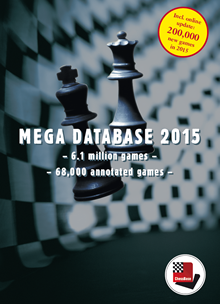
ChessBaseDatabase
Mega Database 2015
2014
http://www.chessbase.com
E-Mail info@chessbase.com
Price €159.90
ISBN: 978-3-86681-452-3
EAN: 9783866814523
Pentium PC, Windows 8,
Windows 7/Vista/XP, 512 MB RAM, DVD-ROM drive, ChessBase 11, 12 or 13,
Internet connection required for online updates
The brand new MegaBase 2015 is now good for over 6.1 million games
{exactly counted 6161344 games}where 68000 of them cover excellent
commentary.
All games are sorted into the ChessBase SuperKey, this is based on the
famous Informant ECO classification and is good for over 106707 entries.
ChessBase sorts games according to General themes as Tactics,Strategy
and Endgames,and this all can be accessed with only one click of your
mouse.
Included is a Mega-Update for the year 2015,and that is a good for
around 200.000 new games.
Going throw this MegaBase is more than fun,for example please see the
games of the first child prodigy in chess, the brilliant Gioachino
Greco 1600-1634 who became later the symbol of an entire age. Born in
the small town of Celico in the province of Calabria,the Neapolitan
Kingdom.
Greco grew up in a poor family and the stories of his childhood did not
give much happiness ,but never less Greco managed to learn chess at the
age of 8 and by the age of 10 he was well known around Italy.
Greco was known for the line 1.e4 e5 2.Nf3 f5 3.Nxe5 Qe7 which even
carries his name but as you can see on the MegaBase file Polerio
1548-1612 mentioned it before.
All together there are 56 entries with the Greco line in the 2015
MegaBase and each one is worth playing throw!
A high class example is:Fuchs,Heinz (2290) - Vogler,Tilmann (2315) [C40]
BL2-Sued 0809 Germany (2.6), 26.10.2008
1.e4 e5 2.Nf3 f5 3.Nxe5 Qe7 4.Qh5+ g6 5.Nxg6 Qxe4+ 6.Be2 Nf6 7.Qh3 hxg6
8.Qxh8 Qxg2 9.Rf1 Kf7 10.Qh4 Nc6 11.d3 b5 12.Qg3 Qxg3 13.hxg3 Nd4
14.Bd1 Bb7 15.Be3 Re8 16.c3 Nf3+ 17.Bxf3 Bxf3 18.Nd2 Bh5 19.Rh1 Ng4
20.Nf1 Bh6 21.Kd2 Nxe3 22.Nxe3 f4 23.gxf4 Bxf4 24.Rae1 Kg7 25.Kc2 Rf8
26.Reg1 Bf3 27.Rh3 Bd6 28.Kd2 c5 29.Ke1 a5 30.Kd2 Be5 31.Rg5 d6 32.Rg1
b4 33.Nc4 bxc3+ 34.bxc3 Bf4+ 35.Kc2 Bd5 36.Rb1 a4 37.Re1 Rf7 38.f3 Rb7
39.Reh1 Kf6 40.Re1 a3 41.Rb1 Re7 42.Kd1 Be6 43.Rh8 Bf5 44.Rb6 Kg7
45.Rhb8 Re6 46.Rd8 Bxd3 47.Nxd6 Be2+ 48.Kc2 Re7 49.Re8 Rxe8 50.Nxe8+
Kh6 51.Kb3 Bd1+ 52.Kc4 Be2+ 53.Kd5 Bxf3+ 54.Ke6 Be2 55.Nd6 Kh5 56.Rc6
Be3 57.Ke5 Kg4 58.Ne4 g5 59.Nxc5 Bb5 60.Rc8 Kf3 61.Ne6 g4 62.Nd4+ Bxd4+
63.Kxd4 g3 64.Rf8+ Ke2 65.c4 Bd7 66.Rg8 Kf3 67.Rxg3+ ½-½
Conclusion:This is ChessBase
on it's best!
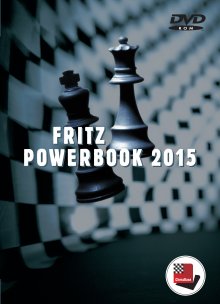
Fritz Powerbook 2015
2014
http://www.chessbase.com
E-Mail info@chessbase.com
Price €49.90
This new PowerBook 2015 holds over 21 millions openings
positions, yes compare that with some classic home computers who had
only a openings book from
around 5000 moves.
These PowerBook are truly unbelievable over filled with chess data,this
all is derived from 1,5 million high class tournament games.
All kind of useful chess information is stored there, as all moves that
where played in the position, rating, success and performance results.
With this you can replay the games in which the position occurred
and there is no printed book that can stand up against it!
Yes not even a overloaded book shelf with openings books.
Included is a smaller but super strong Openings book and hugh database
from over 1.5 million games.
Conclusion: These Powerbooks transfer your Fritz or ChessBase in a
incredible openings alien!
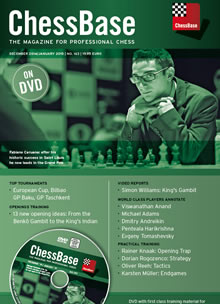
ChessBase Magazine issue 163
2014
December/January 15
http://www.chessbase.com
E-Mail
info@chessbase.com
ISSN 1432-8992
Price Euro 19.95
The tournament file on this heavy loaded DVD is good for
194 entries and 19 well analysed games as for example the following one
from Stohl:
Laznicka,Viktor (2675) - Rapport,Richard (2713) [E69]
Novy Bor m Novy Bor (3), 02.10.2014
[Stohl,I]
1.d4 d6 2.Nf3 Nf6 3.c4 g6 4.g3 Bg7 5.Bg2 0-0 6.0-0 Nbd7 7.Nc3 e5 8.h3
c6 9.e4 Qb6 10.Re1 [The most recent high-level example in the sharp
line 10.c5!? went 10...dxc5 11.dxe5 Ne8 12.e6 fxe6 13.Ng5 Ne5 14.f4 Nf7
15.Nxf7 Bd4+ 16.Kh2 Rxf7 17.e5 Qc7 18.Ne4 b6 19.Qc2 Ba6 20.Rd1 Rd8
21.a4 c4 22.Bf1 c5 23.Bxc4 Bxc4 24.Qxc4 Qc6 25.Qe2 Kh8 26.Ra3 Rfd7
27.g4 Rd5 28.Rf1 c4" Pantsulaia,L (2595)-Kotronias,V (2564)/EU-chT
Warsaw/2013/;
10.d5 Nc5 11.Qe2 Qa6!? 12.dxc6 bxc6 13.Rd1 Ne8 14.Bg5 Qb7 15.Rab1 a5
16.Be3 Ne6÷ 17.Ng5?! Nd4 18.Bxd4 exd4 19.Na4 Qb4 20.Qc2 c5 21.a3
Qb8 22.b4 axb4 23.axb4 Qa7³ Stangl,M (2490)-Volke,K
(2425)/Munich/1992/] 10...exd4 11.Nxd4 Re8 This is one of Black's 2
main continuations. Played already by a past KID great as Geller, the
rook move is also the Kotronias's choice in his huge book about the
Fianchetto KID. [The other popular move 11...Ne8 12.Nb3 a5 13.Be3 Qb4
14.Nd4 a4 15.a3 Qa5 ¹16.Qc2 (This saves a tempo. <16.Qe2 Nef6
17.Rad1 Re8 18.f4 Nc5 19.Qc2 Nfd7 20.Bf2 Bf8 21.Kh2 Qc7 22.Na2 Nf6
23.Nc3 Nfd7 24.Na2 Nf6 25.Nc3 Nfd7 26.Na2 ½, Ruck,R
(2579)-Markus,R (2625)/Ljubljana/2012/) 16...Nc5 17.f4 Nf6 18.Rad1 Re8
19.Bf2 h5 leads to a position, in which a3 has solidified the position
of ¤c5, but Black has lost quite a lot of time to achieve this.
Here Avrukh recommends 20.Nf3!? Be6 21.Rxd6 Bxc4 22.e5 Nfd7 23.Nd2 Be6
24.Nce4 Nxe4 25.Nxe4 Qc7 26.Rd4 Bb3 27.Qc3 Red8 28.Rb4 Bd5 29.Rd1 Qb8
30.h4 b5 31.Qe3 Bf8 32.Rbd4 Be7 33.Rxd5 cxd5 34.Rxd5 Nf8 35.Nc3©
f, Flitsch,G (2315)-Hechl,G (2230)/email/2011/] 12.Nc2 White
immediately sets his sights on d6. [12.Na4 Qc7 (12...Qa5 13.Bf4 Ne5
14.b3 a6!? is another rare, but interesting recommendation by
Kotronias: 15.Bd2 Qc7 16.Nc3 b5 17.Qe2 b4 18.Na4 c5 19.Nc2 Bd7 20.Nb2
Bc6 21.f3 Nfd7 22.Rab1 f5! 23.Ne3 fxe4 24.fxe4 Nf6f Onoda,H
(2365)-Cilento,F (2485)/email/1998/) 13.Bf4 Ne5 14.Rc1 (After 14.Qc2
Black can get counterplay with 14...Bd7! 15.Rad1 Qa5 (15...Qc8!? 16.Kh2
b5" Kotronias) 16.b3 b5 17.Bd2 (17.Nb2 Rab8÷) 17...Qa6 18.Nb2
bxc4 19.Nxc4 Nxc4 20.bxc4 Rab8 21.Bf4 Rb4 22.Bf1 (22.Bxd6!? Rxc4
23.Qd3²) 22...c5 23.Nb3 Rb6 24.e5f Etchechoury,G (2555)-Barrios
Troncoso,J (2507)/email/2004/) 14...b6 15.Be3 Bb7 16.f4 Ned7 17.Nc3 a6
18.Bf2 Rad8 19.b4 c5 20.Nd5 Qb8 21.Nc2 Khismatullin,D
(2534)-Kotronias,V (2598)/Moscow 2004/CBM 100/[Stohl,I] 21...b5÷
/³;
The older move, played already by Botvinnik and subsequently preferred
by Avrukh, is 12.Re2 Qb4 (Forces White to displace his rook, but this
is often only temporary. Deserving attention is also 12...Nc5 13.Be3
Qa6!? 14.Bf4 (14.Nb3 Qxc4!? (14...Na4 15.Nxa4 Qxa4") 15.Nxc5 dxc5
16.Rc1 Qb4 17.a3 Qa5 18.Rd2 c4 19.f4 Bf5 20.e5 Bf8 21.Bf2 Nh5 22.g4
Nxf4 23.gxf5 Qxe5 24.fxg6 hxg6÷ Antonenko,V (2519)-Ponomarev,A
(2488)/email/2008/) 14...Qxc4 15.Rc2 (More critical seems to be 15.Bxd6
Ncxe4!? 16.Bxe4 Nxe4 17.Nxe4 Bd7 18.Bc5 b6 19.Nd6 Qxc5 20.Nxe8
Rxe8©) 15...Nfxe4 (15...Qa6!?³) 16.Nxe4 Qxd4 17.Nxd6 Rd8
18.Rd2 Qb4 19.Rc1 Ne6 20.Be3 Qa5 21.Qb3 Qxd2!? 22.Bxd2 Rxd6 23.Be3 Nd4
24.Qb4 Rd8 25.Kh2 a5 26.Qe7 Bd7 27.Bxd4 Bxd4 28.Rd1 Be6= Gelfand,B
(2733)-Nakamura,H (2774)/Monte Carlo rpd blindfold/2011/) 13.Rc2 Nc5
14.Bd2 Qb6 15.Be3 Qc7 16.f3 a5 17.b3!? Takes the sting out of the space
winning a4. (17.Qd2 a4! 18.Rd1 Nfd7 19.Qf2 Ne5! (<19...Qa5 20.g4 Nf6
21.Nde2 Bf8 22.Ng3 Nfd7 23.f4 Nb6 (23...Be7 24.Nce2 Qc7 25.g5 Bf8 26.h4
Na6 27.Rcd2 Ndc5 28.Bd4 Be6 29.Bc3, Kroll,O (2244)-Dogan,N/email/2011/)
24.Nce2 Be6 25.b3 axb3 26.axb3 Qa3 27.Nd4 Bc8 28.Bc1 Qa6 29.Bb2 Bg7
30.Kh2! Qa7 31.Ndf5!± Berg,E (2627)-Jones,R
(2361)/Caleta/2011/CBM 141/[Berg,E]) 20.Bf1 Qe7 21.Rcd2? (21.Bc1!?
Qf6") 21...f5 22.f4 Ned7 23.Nde2 fxe4 24.Qg2 Nd3 25.Bd4 N7c5 26.Bxg7
Qxg7 27.Nxe4 Nxe4 28.Rxd3 Qxb2µ Banusz,T (2598)-Berkes,F
(2677)/Gyula/2013/) 17...h5 (Kotronias gives the line 17...Nfd7 18.Bf2
h5 19.f4 Nf6 20.Re2 Bd7 21.Qc2 Qc8 22.f5!? gxf5 23.exf5 Rxe2 24.Ncxe2
d5 25.cxd5 cxd5 26.Rc1 (26.Nc3!?) 26...Nce4= It's difficult to judge
such a long unforced line, perhaps White can hope for more by
postponing f4 as in Grachev's game below.) 18.Bf2 Bd7 19.Qf1 Re7 20.Rd1
Rae8 21.Nde2 Bc8 22.Rcd2 Rd7 23.Be3 b6 24.Bf4 Bf8 25.Qf2 Ne6 26.Be3 Nc5
27.Bf4 Ne6 28.Be3 Nc5 29.g4 hxg4 30.hxg4f Grachev,B (2669)-Fier,A
(2572)/Zuerich/2013/] 12...Nc5 While this is a typical and often played
reaction, it's not ideal. [The same can be said about 12...Ne5 13.b3
Be6 14.Be3 (14.Nd4!?²) 14...Qa5 15.Bd2 Qb6 16.Rc1 Rad8 17.Be3 c5
18.Nd5 Bxd5 19.cxd5 Qa5 20.a3 Rc8 21.f4 Ned7 22.Bf2 Re7 23.Kh2 Ne8
24.Qd3 b5 25.b4f 1-0 Kraemer,M (2456)-Jochens,T/Kiel 2008/EXT 2009
(40);
More to the point is 12...Qa5 13.Bd2 (13.Be3 Ne5 14.b3 Nxc4! 15.Bd4 Nb6
16.b4 Qg5 17.Rc1 Be6 18.b5 c5 19.Be3 Qh5 20.Na3 Qxd1 21.Rexd1 Rad8
22.Rc2 ½, Greco,C-Jorgensen,E/email/1999/ 22...Rd7µ)
13...Qc7 14.b3 a6 15.Rc1 Nh5 16.Ne3 (16.Re2 Ne5 17.Ne1 b5 18.cxb5 axb5
19.Nxb5 Qb8 20.Nc3 Ba6 21.Re3 Bh6 22.f4 Qa7 23.Kh1 Rad8 24.a4 Rb8!?
25.Nb1 d5 26.exd5 cxd5 27.Kh2 Nxf4 28.Rxe5 Rxe5 29.Bxf4 Bxf4 30.gxf4
Rf5 31.Nc3 Rb4 32.Nb5 Bxb5 33.axb5 Rxb5 34.Nd3 Qd4 35.Rc8+ Kg7 36.Qc2
Ra5 37.Qc3 Qxc3 38.Rxc3 Ra3= is another long, but unforced line, given
by Kotronias.) 16...b5 (16...Nc5!? 17.Qc2 Nf6÷) 17.cxb5 axb5
18.Nf5! Qb8 19.Nxg7 (19.e5!? Nxe5 20.Nxg7 Nxg7 21.Ne4©) 19...Nxg7
20.Bh6 b4 21.Na4 c5 Hera,I (2559)-Biolek,R (2418)/Ruzomberok/2014/
22.e5f;
12...Qc7 13.b3 Nh5 (13...a6 14.Ba3 Bf8 15.Qd2 b5 16.Rad1 Nc5 17.Qd4!
Nfd7 18.Bb2 Ne5 (18...f6 19.Ne2²) 19.f4 Ne6 20.Qf2 Nd7 21.Nd4 Nxd4
22.Qxd4 Qa7 23.Qxa7 Rxa7 24.e5± Bu,X (2662)-Li,S
(2558)/CHN-chT/2013/) 14.Qd2 Nc5 15.Bb2 (According to Kotronias, 15.Ba3
Be6 16.Rad1 Rad8 17.Qe3 Bc8 18.f4 poses Black more problems, but
18...b6" , but still gives him sufficient counterplay) 15...Be6 16.Rad1
Rad8 17.Nd4 a5?! (17...a6 or; 17...Bc8" are more in the spirit of the
position.) 18.Qc2 Qb6 19.Nce2! Bd7 20.g4 Nf6 21.Ng3 h6 22.Bc3 Qc7
23.Nde2 Nh7 24.Qd2 Bxc3 25.Nxc3 Re6 26.f4f Sage,F (2395)-Krapivtsev,A
(2000)/email/2006/] 13.b4 [13.Qxd6? Rd8 14.Qf4 Nd3µ] 13...Ncd7
This pawn sacrifice is a double-edged attempt to improve upon [13...Ne6
14.Be3 Qc7 (14...Qa6 15.a4! Ng4 16.Bd2 Ne5 17.a5 b5 18.cxb5 cxb5 19.Nd5
Bb7 20.Bc3 Rac8 21.Nce3 Nc7 22.Bd4² fredi_z,d (2633)-erdo,b
(2405)/Engine Room/2012/) 15.Qd3 a5 16.a3 Nd7 17.f4 Nb6 18.Red1!?
(18.Rad1 axb4 19.axb4 Na4 20.Nxa4 Rxa4 21.Qxd6 Qxd6 22.Rxd6 c5 23.f5
(¹23.bxc5! Nxc5 24.Bf2 Rxc4 25.Na3f) 23...Nd4 24.Nxd4 cxd4 25.Bxd4
Bf8 (25...Bxd4+ 26.Rxd4 Rxb4") 26.Bc5! Bxf5 27.e5 Bxd6 28.Bxd6©
Portisch,L-Stein,L/Sousse izt/1967/) 18...axb4 (18...Nd7 19.Rac1 axb4
20.axb4 h6 21.Rd2 Nb6 22.f5 Ng5 23.Bf4 Qd7 24.h4 Bxc3 25.Qxc3 Nxe4
26.Bxe4 Rxe4 27.Bxh6, Salai,J (2075)-Hynes,T (1525)/email/2002/)
19.axb4 Rxa1 20.Nxa1 Nf8 21.c5 dxc5 22.bxc5 Nbd7 23.Nb3 Ne6 24.e5
Rickers,G-Marcinkiewicz,J/corr/1977/ 24...f6!² /"] 14.Qxd6 Ne5N A
natural novelty. Black wants to exploit White's exposed position, which
leads to great tactical complications. [14...Bf8 15.Qd1 a5 16.c5
(16.Be3±) 16...Qc7 17.Bf4 Ne5 18.a3 Nh5 19.Qe2 (¹19.Be3)
19...Be6 20.Nd5 cxd5 21.exd5 Nxf4 22.gxf4 Nc6!? 23.dxe6 Rxe6 24.Qc4
Rf6² /", Wright,J-Siemms,R/corr/1982/;
14...c5 15.bxc5 (15.Nb5!? Qd8 16.Qd1±) 15...Nxc5 16.Qxb6 axb6
17.Rb1 Be6 18.Ne3 Nfd7 19.Ned5 Bxc3 20.Nxc3 Bxc4 21.Bh6 f6 22.Bf1 Bxf1
23.Kxf1 Kf7= Gutzeit,R-Winterstein,W (2280)/Hessen/1991/;
An engine recommendation is 14...Nh5 , but after 15.Na4 a) 15.c5 Nxc5!
is Black's idea: 16.bxc5 (16.e5 Nd7 17.Be3 Qd8) 16...Qa5 17.Bd2 (17.Nb1
Bxa1 18.Bd2 Qxa2 19.Nxa1 Qxa1 20.g4 Bxg4 21.hxg4 Rad8 22.Bc3 Qa4 23.Qc7
Rd1 24.gxh5 Rxe1+ 25.Bxe1 Qd1 26.Qa5 Qxb1÷) 17...Bxc3 18.Bxc3
Qxc3 19.Nd4 Ng7"; b) 15.Bb2 Ne5 16.Na4 (16.c5 Qa6 17.Ne3 Bxh3
(17...Be6!?) 18.Bxh3 Rad8 19.Qc7 Nf3+ 20.Kg2 Be5 21.Qa5 Nxe1+ 22.Rxe1
Qxa5 23.bxa5 Rd2 24.Rb1 Bxg3 25.Ncd1² /÷) 16...Qa6 17.Nc5
Qxc4 18.Qd1 Bxh3 (18...Nf3+ 19.Bxf3 Bxb2 20.Rb1 Bc3 21.Re3 Bxb4
22.Nxb7²) 19.Bxh3 Rad8 20.Bd4 (20.Qe2 Qxe2 21.Rxe2 Nf3+ 22.Kg2
Nh4+! 23.Kf1 Bxb2 24.Rb1 Bg7 . 25.gxh4 Nf4 26.Re3 b6 27.Nb3 Nxh3
28.Rxh3 Rxe4©) 20...Rxd4 21.Nxd4 Qxd4 22.Qb3 a5²; 15...Qa6
16.Nb2 Ne5 (16...Nb6 17.Qd3±) 17.b5 cxb5 18.Qxa6 bxa6 19.g4 bxc4
(19...Nf6 20.f4 Nxc4 21.e5 Rb8 22.Nxc4 bxc4 23.Be3 Nd7 24.Bxa7 Rb2
25.Ne3±) 20.gxh5 Bxh3 (20...Nd3 21.Nxd3 cxd3 22.e5±)
21.h6 Bxg2 22.Kxg2 Bf6 23.Rb1± Blkack's compensation is hardly
sufficient.;
<14...Ng4 15.c5 Qd8 16.Bb2 Nge5 17.Ne3 Nxc5 18.bxc5 Nd3 19.Qxd8 Rxd8
20.Rad1 Be6 21.Ba1 Nxe1 22.Rxe1±] 15.c5 [15.Be3 Nxc4 16.Bxb6
Nxd6 17.Bd4 Nc4 18.b5² is pleasant for White, but Laznicka wants
more than that.] 15...Qa6 16.Bf4 [16.b5? Qa5 17.Bd2 Nc4µ;
16.Bf1?! Nf3+ 17.Kh1 Nxe1 18.Bxa6 Nxc2 19.Bg5 Nh5! (19...Re6 20.Qd8+
Re8=) 20.Rc1 Bxc3 21.Rxc2 Be5 22.Bxb7 Bxb7³ /µ;
16.Bg5 Bxh3 (16...Nh5 17.Nd5!? Nc4 18.Ne7+ Kh8 19.Qd1÷) 17.Bxf6
Bxg2 18.Kxg2 Bxf6 19.Qxf6 Qd3³ wins the piece back and Black
retains the initiative.;
16.f4! is the principled and probably strongest move, but the tactics
are still difficult to unravel over the board after 16...Bxh3!?
(16...Qd3 17.Qxd3 Nxd3 18.Re3 Nxc1 19.Rxc1² /±; 16...Nc4
17.Qd3 Be6 18.Nd4±) 17.fxe5 (17.Bxh3? Nf3+ 18.Kf2 Nxe1-+)
17...Rad8 18.Bxh3 (18.Qc7 Rd7 19.Qa5 Qd3©) 18...Rxd6 19.cxd6 Qd3
(19...Rxe5 20.Bf4!? (20.Bf1 Qb6+ 21.Be3 Qd8 22.Rad1²) 20...Rh5
21.e5 Rxh3 22.exf6 Bxf6 23.Rad1 Bxc3 24.Re8+ Kg7 25.d7 Bf6 26.Be5 Bxe5
27.d8Q Qc4 28.Rg8+ Kh6 29.Qd2+ Kh5 30.Nd4 Rxg3+ 31.Kf2 and White has
good chances to win this wild position, but there is no guarantee after
31...Kg4!?² /±) 20.exf6 Bxf6 21.d7 Rd8 22.e5 Bxe5!?
(22...Qxg3+ 23.Bg2 Bxe5 24.Rxe5 (24.Ne4!? Qh2+ 25.Kf1 Rxd7 26.Rb1 Rd3
27.Rb3² /±) 24...Qxe5 25.Ne4 Rxd7 26.Bg5² /f) 23.Rxe5
(23.Ne4 Bxa1 24.Nxa1 f5 25.Bf1 Qd4+ 26.Be3 Qxb4 27.Nc2 Qxe4 28.Bg5 Qxe1
29.Nxe1 Rxd7÷) 23...Qxg3+ 24.Bg2 Qxe5 25.Ne4 Rxd7 26.Bg5f -
22...£xg3 transposes to alternative line on move 22 without
giving White the extra option on move 24.;
16.Rd1 Bxh3! (16...Qc4 17.Qd4²) 17.Bxh3 Qc4 18.Bb2 Nxe4 19.Nxe4
Qxe4 (19...Nf3+ 20.Kg2 Qxe4 21.Bxg7 Ne5+= forces a draw immediately)
20.Bxe5 Bxe5 21.Qd2 Bxa1 22.Nxa1 Rad8 23.Qxd8 Rxd8 24.Rxd8+ Kg7 25.Nb3
Qxb4=] 16...Nh5 17.Bf1 Nc4 The strongest move, which retains the
tension. [17...Nf3+ 18.Kh1 Nxe1 19.Bxa6 Nxc2 20.Rc1 Nxb4 looks complex,
but Black's compensation peters out after 21.Bf1 (21.Bc4!? Be6 22.Bxe6
Rxe6 23.Qd7±) 21...Nxf4 22.Qxf4 Be5 23.Qd2 Be6 24.f4 Rad8
25.Qb2±] 18.Qd3 Bxh3!? [After 18...Be6 19.e5 Rad8 20.Qf3²
Black is struggling to prove compensation, so Rapport ups the stakes.]
19.Bxh3 Rad8 20.Nd5! This generous move is the best reaction. [20.Qf3?
Nxf4 21.gxf4 (21.Bf1 Nd3! 22.Bxd3 Nd2-+) 21...Nd2 22.Qg3 Bxc3 23.Qxc3
Rd3 24.Qf6 (24.b5 Qxb5 25.a4 Rxc3 26.axb5 Rxc2-+) 24...Rxh3µ;
20.Bd7? Nxf4 21.gxf4 Re7µ;
20.Bd6 Nxd6 21.Qxa6 bxa6 22.e5T Nc4 23.Rad1 Nxe5 24.Bg2© gives
White reasonable compensation to hold, but hardly an advantage.
However, Laznicka was trailing and he is an ambitious fighter...]
20...Nxf4 21.gxf4 Bxa1 22.Rxa1 cxd5 23.exd5 b5! Safeguarding the knight
is the best practical chance, otherwise White just plays ¥f1.
[23...g5 24.Bf1 (24.Kh2!? g4 25.Bf1 Qh6+ 26.Kg3 Nb2 27.Qf5f; 24.fxg5
Re5 25.d6 Rxg5+ 26.Kh2 Nxd6 27.Rd1!²) 24...gxf4 25.Qxc4 Qg6+
26.Kh2 Re5 27.Bh3 Rh5 28.Qc3 Rdxd5 29.Rg1 Rdg5 30.Rxg5 Qxg5
31.Qf3²] 24.Qd4?" On the verge of serious time-trouble White
commits a decisive mistake. His idea to prevent the activation of
Black's queen via f6 fails badly to a powerful counterattack. [24.d6?!
Nxd6 25.cxd6 Rxd6f would give up the pawns too cheaply.;
In the post-mortem Rapport suggested the interesting 24.Bg2 Qf6 25.Qd4
(25.a4!? a6 is similar) 25...Qh4 , here White is perhaps better after
26.Re1!?²;
However, White had even better moves: ¹24.a4 Qf6 (24...Qb7 25.Bg2
a6 26.d6 is too passive: 26...Qd7 27.axb5 axb5 28.Ne3 Nxd6 29.Rd1 Re6
30.f5 gxf5 31.Nxf5 Nxf5 32.Qxd7 Rxd7 33.Rxd7+-) 25.axb5 Qxf4 26.Bg2 Ne5
27.Qe3² (27.Qd4!? . 27...Nf3+ 28.Bxf3 Qxf3 29.Ra3 Qxd5 30.Qxd5
Rxd5 31.Rxa7 Rd1+ 32.Kg2 Rd2 33.b6! Rxc2 34.b7+-) ;
24.cxb6!? is a typical antistrategic computer idea, but it's also
strong: 24...axb6 25.a4 b5 (25...f5 26.Bf1 Re4 27.Re1! Rxf4 28.Re7 Rg4+
29.Bg2 Kf8 30.Rxh7+-) 26.axb5 Qxb5 27.Ra5 Qc6 28.Rc5 (28.dxc6 Rxd3
29.Rc5 Nb6 30.Ne3±) 28...Nb2 29.Qd4 Qd6 30.Qxb2 Qxf4 31.Qd4 Re4
32.Qd3±] 24...Re2! The rook penetrates... 25.Ne3 [25.Qc3 Rxd5-+]
25...Nxe3 26.fxe3 Qa3!-+ And now Black's queen joins in from a
different direction. 27.Bg2 [27.c6 Rxd5 28.c7 Rxd4 29.c8Q+ Kg7 30.exd4
Qg3+;
More resilient was ¹27.d6 Rxe3 28.Bg2 Rd3 29.Qe4! a) 29.Qf6 Re8
30.c6 Re2 and the mating attack is faster than the pawns; b) 29.Qe5
Qxb4-+ (29...Rd2-+) ; 29...a5!?-+ White's pawns are stopped and Black
will gradually combine threats against §c5 and the exposed
¢g1.] 27...Re8! The last strong move, activating the only passive
piece. The rest is agony for White. 28.d6 R8xe3 29.d7 Rxg2+! 30.Kxg2
[30.Kf1 Re1+ 31.Kxg2 (31.Kxe1 Qg3+ 32.Kd1 Qf3+ 33.Kc1 Qf1+) 31...Re2+
transposes into the game.] 30...Re2+ 31.Qf2T [31.Kf1 Qf3+] 31...Rxf2+
32.Kxf2 Qb2+ 33.Kg3 [33.Ke3 Qc3+ 34.Ke2 (34.Ke4 Qc4+ 35.Ke3 Qe6+)
34...Qc4+ wins the passed pawn.] 33...Qc3+ 34.Kh4 [34.Kg4 h5+ 35.Kh4
(35.Kg5 Kg7 36.Kh4 Qd2-+) 35...Qd2 36.c6 Qh2+ 37.Kg5 Kg7-+] 34...g5+!?
[34...Qd3 35.c6 f5 36.Rc1 Kf7-+ also wins.] 35.Kg4 [35.fxg5 Qd4+;
35.Kxg5 Qg3+ 36.Kf6 (36.Kf5 Qh3+) 36...Qxf4+ 37.Ke7 Qe5+ 38.Kd8 Qb8+
39.Ke7 Qf8+ 40.Kf6 Qd8+-+] 35...h5+ 36.Kxg5 [36.Kxh5 Qh3+] 36...Qd3
[36...Qd3 37.c6 Qg6+ 38.Kh4 Qg4#] 0-1.\
The high class theory files go to: Illingworth: Reti Opening A11
1.c4 Nf6 2.g3 c6 3.Bg2 d5 4.Nf3 g6 5.b3 Bg7 6.Bb2 0-0 7.0-0,Kuzmin:
Benkö Gambit A58
1.d4 Nf6 2.c4 c5 3.d5 b5 4.cxb5 a6 5.bxa6 g6 6.Nc3 Bg7 7.e4 0-0 8.Nf3
Qa5,Stohl: Benoni A60
1.d4 Nf6 2.c4 e6 3.g3 c5 4.d5 cxd5 5.exd5 b5,Karolyi: Dutch Defence A83
1.d4 f5 2.e4 fxe4 3.Nc3 Nf6 4.Bg5 Nc6 5.d5 Ne5 6.Qd4 Nf7 7.h4,Havasi:
Modern Defence B06
1.e4 g6 2.d4 Bg7 3.Nc3 d6 4.f4 a6 5.Nf3 b5 6. Bd3 Bb7 7.Be3,Krasenkow:
Sicilian B22
1.e4 c5 2.c3 d5 3.exd5 Qxd5 4.d4 e6,Sumets: French C11
1.e4 e6 2.d4 d5 3.Nc3 Nf6 4.e5 Nfd7 5.f4 c6 6.Nf3 Nc6 7.Be3 Qb6 8.Na4
Qa5+ 9.c3 b6,Antic: French C12
1.e4 e6 2.d4 d5 3.Nc3 Nf6 4.Bg5 Bb4 5.e5 h6 6.Bh4 g5 7.Bg3 Ne4
8.Nge2,Müller: King's Gambit C37
1.e4 e5 2.f4 exf4 3.Nf3 g5 4.Nc3,Gormally: Queen's Gambit Accepted D24
1.d4 d5 2.c4 dxc4 3.Nf3 Nf6 4.Nc3 a6 5.e4 b5 6.e5 Nd5 7.a4 e6
8.axb5,Postny: Grünfeld Defence D85
1.d4 Nf6 2.c4 g6 3.Nc3 d5 4.cxd5 Nxd5 5.Bd2 Bg7 6.e4 Nxc3 7.Bxc3 0-0
8.Qd2,Marin: NimzoIndian E41
1.d4 Nf6 2.c4 e6 3.Nc3 Bb4 4.e3 c5 5.Bd3 Nc6 6.Nf3 Bxc3+ 7.bxc3 d6
8.0-0 e5 9.d5 Ne7,and at last the Szabo: King's Indian E98
1.d4 Nf6 2.c4 g6 3.Nc3 Bg7 4.e4 d6 5.Nf3 0-0 6.Be2 e5 7.0-0 Nc6 8.d5
Ne7 9.Ne1 Ne8 10.Be3 f5 11.f3 f4 12.Bf2 h5 13.c5 g5.
Other are Tele files with over 10000 entries,Reeh Tactics,Müller
Endgames where Karsten shows us in a impressive way 30 annotated
endgames, training question and video clips!Rogozenko Strategy,Knaak
Opening traps and various Openings Video as Williams with the King’s
Gambit!!
included is a eye catching booklet in two languages!
Conclusion: Super material!










